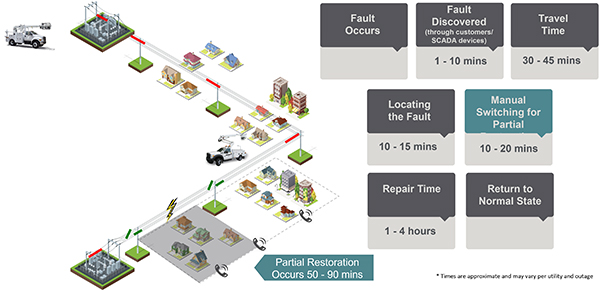Working towards scalable solutions to increase grid resiliency under demand of climate related disasters.
In a battle against Mother Nature, utility companies are facing pressure to improve grid performance as climate events become more frequent and severe. Improving grid reliability and resiliency, weatherizing and ultimately modernizing utilities limits the number of customers impacted and reduces outage times to aid rescues and save lives during disaster.
North America has experienced an upward trend of natural disasters since the 1980s–2020 being the most devastating year to date. Notably, there were wildfires in the West, hurricanes in the East, derechos in the Midwest, and an unprecedented snowstorm named Uri in the South that crippled the state of Texas’s power grid.
According to the National Centers for Environmental Information (NCEI), in 2020 there were twenty-two independent weather and climate disaster events, exceeding $95 billion in damages. By comparison, the entire 1980s decade saw twenty-nine such events.
Climate change is expected to have expansive effects on the electric power grid, causing significant loss for utility companies and customers, creating long-term effects on demands for electricity across industries. As climate change worsens, our electrical system grows more susceptible to power outages, meaning consequences on our society, economy and safety.
Is your power grid prepared for the next climatic outage?

In the last decade, by installing intelligent grid technology like smart reclosers on medium voltage lines, utility companies have reduced the number of customers impacted by outages. Automation capabilities of a recloser enable utilities to have more control over system performance while sectionalizing the grid. For example, if a line goes down during a storm, a recloser can automatically attempt to clear temporary faults and isolate only that section of the grid to protect additional customers from being affected by that fault. Additionally, if the outage requires repairs, reclosers can aid crews in locating the source of the problem to quickly restore power.
To optimize grid resiliency and reliability, utility companies have increased the number of reclosers installed per customer. Previously, it was standard to install one recloser per every 1,800-2,000 customers. Today, a majority of utilities have determined to significantly improve grid reliability, there should be one recloser for every 400-500 customers.
In 2015, the U.S. Department of Energy found seventy percent of power transformers and transmission lines are twenty-five years or older, and sixty percent of circuit breakers are thirty years or older. Under the stress of meeting higher demand, electrical systems are vulnerable against severe weather-related events – leaving our society at risk.
Even with aging infrastructure in place, with the right upgrades and strategic planning, utilities can strengthen their grids to lessen the downtime and help ease escalating outage penalties.
When aging infrastructure does fail, adding distribution automation solutions aids fault location, isolation, and service restoration (FLISR), responds to loss of voltage (LOV) and distributes automation hardware to enable utilities to improve power reliability and quality. Across a utility’s service territory, it can be difficult and time consuming to determine the location of an outage before dispatching a crew to fix it.
To meet the power grid needs of today and tomorrow, utilities should consider partnering with manufacturers that offer a comprehensive menu of pre-engineered automation solutions — from simple automatic transfer schemes to complex SCADA/master station configurations.
For utilities in the western U.S., it could be beneficial to work with a partner capable of developing fire mitigation strategies that can be rapidly implemented across their electrical infrastructure. Products available on the market offer flexible solutions that help reduce wildfire risk to address safety concerns and satisfy regulatory mandates such as Public Safety Power Shutoff (PSPS) requirements.
To improve system protection against wildfires, advanced recloser control solutions detect downed lines and stop power flow, providing location alerts to help crews zero in on the fallen conductor. By installing this equipment, utilities can reduce sparking caused by electrical lines and address the source of fire ignition.
Utilities are not the only ones realizing the need to invest in our electrical system; so are government officials. As part of the plan to improve the nation’s infrastructure systems, the current administration is seeking to modernize the electric grid to make it more reliable and less susceptible to outages while adding clean energy from wind and solar.
While other upgrades will be necessary to completely weatherize our electrical systems, implementing scalable solutions will improve the reliability and performance of our power grids with integrated automation solutions in place. Working with a partner that can provide solutions tailored to each region’s needs allows utilities to quickly install equipment that keeps the lights on now and in the future.

Shawntia Mcneil is a Power Grid Business Development Manager for G&W Electric’s LaZer Automation team based out of San Antonio, Texas. She leads growth and strategy across Western USA/Mexico. Shawntia’s professional career spans over 18 years across various disciplines as a subject matter expert within the Consumer Products, Energy/Defense/Technology, and Electrical Manufacturing industries. Shawntia holds a B.S in Electrical Engineering from Tennessee State University, an MBA in Finance from the University of Houston, a Leadership Certificate from Cornell University, and is working to become proficient in the Spanish language. She is an active member of NSBE (National Society of Black Engineers) and SWE (Society of Women Engineers). Shawntia is an advocate speaker promoting the need for Automation and Grid resiliency. She has been a notable speaker at many summits including the Military Smart Grids and Microgrids Conference in Arlington, VA where she presented for government officials and her work has been cited by EPRI (Electric Power Research Institute). Shawntia believes strongly in being a pioneer for women and diversity in STEM and aspires to be a prominent future leader within the STEM field.
https://www.linkedin.com/in/shawntiarmcneil
Scott Ellyson, CEO of East West Manufacturing, brings decades of global manufacturing and supply chain leadership to the conversation. In this episode, he shares practical insights on scaling operations, navigating complexity, and building resilient manufacturing networks in an increasingly connected world.